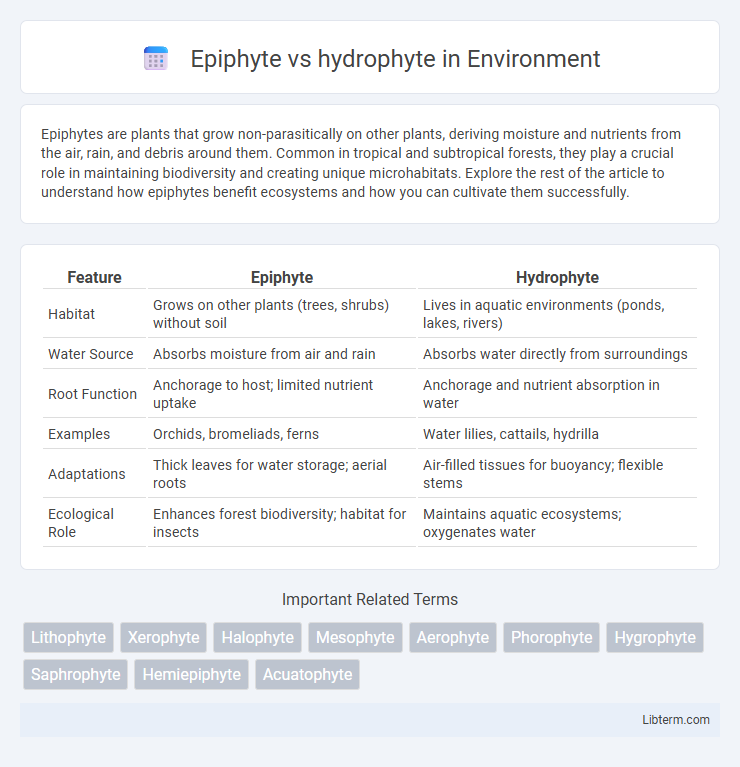Epiphytes are plants that grow non-parasitically on other plants, deriving moisture and nutrients from the air, rain, and debris around them. Common in tropical and subtropical forests, they play a crucial role in maintaining biodiversity and creating unique microhabitats. Explore the rest of the article to understand how epiphytes benefit ecosystems and how you can cultivate them successfully.
Table of Comparison
| Feature | Epiphyte | Hydrophyte |
|---|---|---|
| Habitat | Grows on other plants (trees, shrubs) without soil | Lives in aquatic environments (ponds, lakes, rivers) |
| Water Source | Absorbs moisture from air and rain | Absorbs water directly from surroundings |
| Root Function | Anchorage to host; limited nutrient uptake | Anchorage and nutrient absorption in water |
| Examples | Orchids, bromeliads, ferns | Water lilies, cattails, hydrilla |
| Adaptations | Thick leaves for water storage; aerial roots | Air-filled tissues for buoyancy; flexible stems |
| Ecological Role | Enhances forest biodiversity; habitat for insects | Maintains aquatic ecosystems; oxygenates water |
Introduction to Epiphytes and Hydrophytes
Epiphytes are plants that grow on other plants or objects for physical support, deriving moisture and nutrients from the air, rain, and debris accumulating around them, commonly found in tropical rainforests. Hydrophytes are aquatic plants adapted to grow in water or water-saturated environments, with specialized structures like aerenchyma to facilitate gas exchange in submerged conditions. Both epiphytes and hydrophytes exhibit unique adaptations that enable survival in distinct ecological niches with limited soil interaction.
Defining Epiphytes: Characteristics and Types
Epiphytes are plants that grow non-parasitically on other plants, primarily trees, using them for physical support without extracting nutrients from the host. They exhibit specialized adaptations such as aerial roots for moisture absorption and the ability to capture nutrients from debris and rainwater, enabling survival in nutrient-poor environments. Common types of epiphytes include orchids, bromeliads, and ferns, all of which contribute to biodiversity and ecosystem complexity in tropical and temperate forests.
Hydrophytes Explained: Key Features and Adaptations
Hydrophytes are plants adapted to thrive in aquatic environments, exhibiting specialized features such as aerenchyma tissues for buoyancy and efficient gas exchange. Their roots are often reduced or modified to anchor in water or soft substrates, while stomata may be absent or located on the upper leaf surface to optimize gas exchange. These adaptations enable hydrophytes like water lilies and cattails to survive and reproduce effectively in submerged or partially submerged habitats.
Distinct Habitats: Where Epiphytes and Hydrophytes Thrive
Epiphytes thrive primarily in tropical and subtropical forest canopies, growing on trees without soil contact, where they access moisture from air and rain. Hydrophytes are adapted to aquatic environments, thriving in freshwater bodies like ponds, lakes, and marshes, often having specialized structures for submerged or floating growth. These distinct habitats drive specific adaptations in epiphytes and hydrophytes to optimize nutrient acquisition and survival.
Morphological Differences Between Epiphytes and Hydrophytes
Epiphytes exhibit aerial roots and thick, waxy leaves to minimize water loss while anchoring to host plants, contrasting with hydrophytes that possess specialized structures such as aerenchyma for buoyancy and extensive stomatal distribution on upper leaf surfaces to facilitate gas exchange in aquatic environments. Epiphytes typically lack true root systems for nutrient absorption from soil, relying instead on atmospheric moisture and debris, whereas hydrophytes have reduced or modified roots primarily for anchorage and nutrient uptake from water. These morphological adaptations reflect their distinct ecological niches, with epiphytes adapted to terrestrial, non-soil habitats and hydrophytes specialized for submerged or floating aquatic life forms.
Examples of Common Epiphytes and Hydrophytes
Common epiphytes include orchids, bromeliads, and staghorn ferns, which thrive by growing on tree branches and deriving moisture from the air. Typical hydrophytes such as water lilies, lotus, and cattails are adapted to aquatic environments, with specialized structures like air-filled tissues that aid buoyancy. These plant types demonstrate distinct ecological adaptations, with epiphytes maximizing vertical space in forests and hydrophytes flourishing in freshwater habitats.
Physiological Adaptations for Survival
Epiphytes possess specialized adaptations such as trichomes for water absorption and CAM photosynthesis to minimize water loss, enabling survival in nutrient-poor and moisture-variable aerial environments. Hydrophytes exhibit features like aerenchyma tissue for buoyancy and gas exchange, along with reduced or absent cuticles to facilitate efficient underwater nutrient and gas uptake. These physiological traits directly support their survival by optimizing water and nutrient management in contrasting habitats.
Ecological Roles in Their Respective Environments
Epiphytes contribute to forest ecosystems by enhancing biodiversity and providing habitats for various organisms without extracting nutrients from the soil, relying instead on moisture from the air and rain. Hydrophytes play a crucial role in aquatic environments by stabilizing sediment, improving water quality through oxygenation, and serving as food and shelter for aquatic wildlife. Both plant types exemplify specialized adaptations that support ecosystem functionality and resilience in their respective terrestrial and aquatic habitats.
Human Uses and Benefits of Epiphytes vs Hydrophytes
Epiphytes provide unique benefits in horticulture and air purification due to their ability to thrive without soil, serving as natural air filters and enhancing indoor aesthetics. Hydrophytes, essential in aquatic ecosystems, aid in water purification, erosion control, and provide food sources such as water chestnuts and lotus for human consumption. Both plant types contribute significantly to biodiversity conservation and sustainable agriculture practices, with epiphytes supporting forest ecosystems and hydrophytes fostering healthy aquatic habitats.
Conclusion: Key Differences and Summary
Epiphytes grow on other plants for physical support without harming the host, thriving in well-aerated environments by absorbing moisture and nutrients from air and debris, whereas hydrophytes are aquatic plants adapted to submerged or waterlogged habitats with specialized structures like aerenchyma for buoyancy and gas exchange. Epiphytes lack roots in soil and rely on atmospheric inputs, while hydrophytes possess adaptations for water absorption and oxygen transport in saturated conditions. Understanding these fundamental differences highlights their unique survival strategies and ecological roles in terrestrial versus aquatic ecosystems.
Epiphyte Infographic

 libterm.com
libterm.com